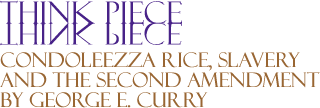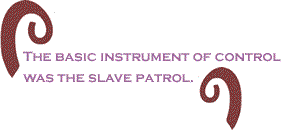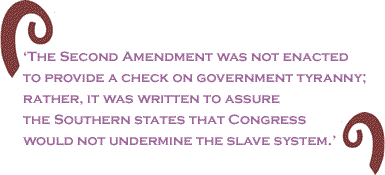
|
|||||||||||||||||||||
|
In a recent column I took Secretary of State Condoleezza Rice to task for misinterpreting the Second Amendment right to bear arms. In retrospect, I realize I owe her an apology. From the bottom of my heart, I apologize to Secretary Rice – for being too light on her. For those who missed it, Rice appeared on CNN’s Larry King Live May 11 and talked about her father and his friends arming themselves against nightriders in Birmingham, Ala. in 1962 and 1963. She said, “…We have to be very careful when we start abridging rights that our Founding Fathers thought very important. And on this one, I think that they understood that there might be circumstances that people like my father experienced in Birmingham, Ala., when, in fact, the police weren’t going to protect you.” I took issue with her. Since then, a reader has directed me to a fascinating 100-page article in the University of California-Davis Law Review [Winter 1997] by Carl T. Bogus titled, “The Hidden History of the Second Amendment.” The Second Amendment reads: “A well regulated militia, being necessary to the security of a free state, the right of the people to keep and bear arms, shall not be infringed.” Bogus, an associate professor at Roger Williams University Law School, wrote: “The Second Amendment was not enacted to provide a check on government tyranny; rather, it was written to assure the Southern states that Congress would not undermine the slave system by using its newly acquired constitutional authority over the militia to disarm the state militia and thereby destroy the South’s principal instrument of slave control.” He explains, “The Second Amendment’s history has been hidden because neither James Madison, who was the principal author of the Second Amendment, nor those he was attempting to outmaneuver politically, laid their motives on the table.”
In 1779, Virginians met in Richmond to decide whether to ratify the United States constitution. With eight of the needed nine colonies already on board, all eyes were on Virginia, the home of Thomas Jefferson, James Madison and Patrick Henry. Whether the newly-formed union would eradicate slavery was uppermost on their minds. Professor Bogus writes, “’Slavery was not only an economic and industrial system,’ one scholar noted, ‘but more than that, it was a gigantic police system.’ Over time the South developed an elaborate system of slave control. The basic instrument of control was the slave patrol, armed groups of white men who made regular rounds. The patrols made sure that blacks were not wandering where they did not belong, gathering in groups, or engaging in other suspicious activity. “Equally important, however, was the demonstration of constant vigilance and armed force. The basic strategy was to ensure and impress upon the slaves that whites were armed, watchful, and ready to respond to insurrectionist activity at all times. The state required white men and female plantation owners to participate in patrols and to provide their own arms and equipment, although the rich were permitted to send white servants in their place.” The article noted, “The Georgia statues required patrols, under the direction of commissioned militia officers, to examine every plantation each month and authorized them to search ‘all Negro Houses for offensive Weapons and Ammunition’ and to apprehend and give twenty lashes to any slave found outside plantation grounds.” Bogus said it was clear that the Second Amendment was drafted to protect Southern militias, not broadly allow individuals to arm themselves. “In the South, therefore, the patrols and the militia were largely synonymous,” he discovered. “…The militia was the first and last protection from the omni-present threat of slave insurrection of vengeance.”
When Americans think of militias, they tend to think of minutemen at Lexington and Concord and “the shot heard around the world.” Bogus explains, “Some assume the Founders incorporated the right to bear arms in the Bill of Rights because an armed citizenry had been important to security in colonial America and is essential to throwing off the yoke of British oppression. Much of this is myth.” He concluded, “It cannot be overemphasized that slavery was the central feature of life in slave holding states, and that the South depended on arms and the militia itself against the constant danger of a slave revolt… Southerners had to be infinitely more concerned about slave control than abstract, ideological, or contingent beliefs about liberty and guns.” In other words, Condi, they were not interested in arming your father and his Black buddies. George E. Curry is editor-in-chief of the NNPA News Service and BlackPressUSA.com. He appears on National Public Radio (NPR) three times a week as part of “News and Notes with Ed Gordon.” In addition, his radio commentary is syndicated each week by Capitol Radio News Service (301/588-1993). To contact Curry or to book him for a speaking engagement, go to his Web site, www.georgecurry.com. |
Your comments are always welcome. Visit the Contact Us page to send e-Mail or Feedback or Click here to send e-Mail to [email protected] e-Mail re-print notice
If you send us an e-Mail message we may publish all or part of it, unless you tell us it is not for publication. You may also request that we withhold your name. Thank you very much for your readership. |
| June 16 2005 Issue 142 |
|||||||||
|
|||||||||
|
|
|||||||||
| Printer Friendly Version | |||||||||
 |
|||||||||
 |
|||||||||
| |
|||||||||
| |
|||||||||



























